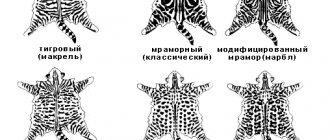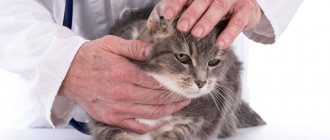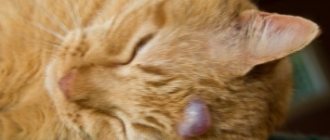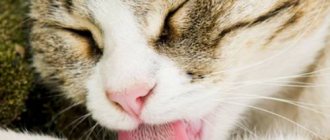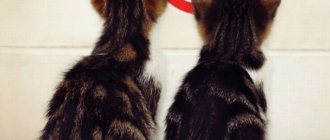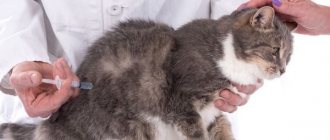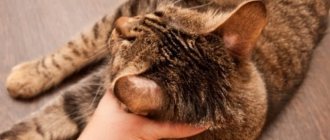Causes of glomerulonephritis Symptoms of glomerulonephritis in cats Diagnosis Treatment Glomerulonephritis in cats is an immune disease, inflammation of the glomeruli, the glomeruli of the kidneys responsible for filtration.
Glomerulonephritis appears as a result of the entry of an immune complex (an immune complex is antibodies associated with antigens) into the renal glomeruli, causing their inflammation, swelling and the formation of scar tissue in place of the functional one. This causes a marked deterioration in the filtering ability of the kidneys and causes blood and proteins to enter the urine.
Description
Glomerulonephritis is a kidney disease in which the glomerular apparatus of an animal becomes inflamed.
Does not belong to the group of infectious diseases of the genitourinary organs. Inflammation develops due to bacteria entering the basement membranes. Harmful substances affect the animal’s immunity, damaging the structure of the glomeruli. Hypothermia can contribute to the rapid development of microorganisms that affect the organs of the genitourinary system. At low temperatures, bacteria multiply rapidly, causing damage to lysosomes. They are responsible for blood clotting. Due to impaired circulation of the blood flow, inflammation of the genitourinary organs occurs, accompanied by a decrease in immunity.
Pathogenesis
The immunological mechanisms of damage to the glomeruli are associated with the formation of specific antibodies that interact with antigens (exogenous - drugs, foreign proteins of microbes, viruses and protozoa) or (endogenous - DNA, antigen of the nuclei and ribosomes of cells, elements of the glomerular basement membrane), with the formation of immune complexes antigen - antibody. Immune complexes, circulating in the blood, are excreted through the glomerular filter and, getting stuck in it, cause damage to the kidney tissue.
Causes
The disease has three forms: acute, subacute and chronic. Glomerulonephritis is detected in cats of different ages, regardless of breed. The disease is often detected in animals between 3 and 5 years of age.
The acute and subacute forms are caused by different irritants. The disease occurs due to infection in the animal's body: Pseudomonas aeruginosa, viruses, leptospirosis and hepatitis. Due to the ingress of harmful substances, sodium is retained in the genitourinary system. It disrupts kidney filtration, which leads to edema. Together, the functioning of the cardiovascular system is disrupted in cats.
Causes of the disease:
- cancer;
- diabetes;
- feline immunodeficiency virus;
- long-term exposure to chemicals and drugs on the body;
- hypothermia of the animal;
- abdominal injuries;
- long-term physical activity;
- being in damp areas;
- taking antibiotics, vaccines or serums;
- decreased immunity.
The causes of glomerulonephritis are diseases: pancreatitis, endocarditis, pyometra. Owners of animals prone to such diseases need to periodically visit a veterinarian and get tested to detect kidney failure.
The cause is often prolonged consumption of dry food. Kidneys need vitamins that are found in vegetables and meat.
Symptoms
Often glomerulonephritis is asymptomatic, periodically showing its presence with pain in the kidney area. An accurate diagnosis is made only on the basis of diagnostics and testing.
Symptoms of glomerulonephritis are varied. They depend on the age of the animal, general health, and form of the disease. Symptoms are more pronounced in the acute form. Cats get very tired, become inactive, and eat little. In the chronic form, which lasts for years, the organs of the cardiovascular and nervous systems are affected.
The appearance of a red, dense liquid in the urine indicates the presence of the disease. Because of this, the discharge becomes brown, dark in color and has an unpleasant odor.
Symptoms of the disease also include:
- decreased appetite;
- excessive fluid intake;
- hair loss;
- deterioration of vision, hearing;
- frequent trips to the toilet;
- indigestion (vomiting);
- increased blood pressure;
- deterioration of general condition, pallor;
- the appearance of edema.
The owner should take their cat to the veterinarian and get diagnosed if the animal has an increased belly size. With glomerulonephritis, it increases in volume, causing pain.
Nephritis in cats
Nephritis
– from Latin nephos
-kidney and
itis
-inflammation - a term that combines various inflammatory diseases of the kidneys. In cats there are:
- Glomerulonephritis
- Pyelonephritis
- Interstitial nephritis
Nephritis in cats can occur:
Nephritis occurs both without changes in kidney function and with the development of acute and chronic renal failure.
Pyelonephritis
- inflammation involving all structures of the kidney, caused by various bacteria (most often E.coli
,
Proteus
,
Staphylococcus
). Often develops against the background of inflammation of the uterus (metritis), urocystitis (inflammation of the bladder, when the patient has not received the necessary treatment for the latter or has undergone an insufficient course for cure), predisposes to the spread of infection - cessation of urine flow when the urinary tract is blocked due to urolithiasis, as well as hematogenous by - i.e. with the bloodstream, when the source may be any source of inflammation in the body or systemic viral/bacterial infections.
Glomerulonephritis
- an autoimmune disease that affects only certain structures of the kidney - glomeruli (glomeruli).
Interstitial nephritis
- inflammation of the kidney tissue of a non-infectious nature with damage to the interstitial tissue and renal tubules. One of the causes of the last stage of kidney loss in cats (nephrosclerosis). The disease is still poorly understood, and intravital diagnosis is difficult.
Often the symptoms of nephritis in cats are nonspecific and similar to signs of other diseases:
- Decreased activity
- Decreased appetite
- Nausea
- Very rarely - shortness of breath
- Pain in the lumbar region - usually detected only during examination by a veterinarian
More characteristic of jade is:
- Increased, but not difficult and usually not painful urination
, much less often - scanty urination; - Increase fluid intake;
- Dry mouth
(in addition to the fact that the cat drinks a lot, it may lick itself frequently); - The urine may have an unpleasant odor;
- May change the color of urine, often becoming cloudy;
- Specific changes in urine analysis
(appearance of a large number of leukocytes, red blood cells, protein, renal epithelium, casts); - Increased body temperature
is relatively uncommon in cats with acute nephritis; - Very rarely in cats there is swelling of the limbs and other parts of the body.
- Ultrasound of the kidneys and bladder;
- Analysis of urine;
- Clinical and biochemical blood tests;
- Determination of urine protein/creatinine ratio;
- In some cases, a kidney biopsy (taking a tiny piece of kidney tissue using a special needle) may be recommended to determine the exact diagnosis.
Laboratory diagnostic methods
Once symptoms are detected, the owner will have to take the animal to a veterinary clinic. Diagnosis begins with a physical examination. The doctor examines the cat's belly, then the front legs and head for swelling.
To confirm the diagnosis, the body is examined:
- Taking a urine test to show the presence of bacteria in the discharge.
- Taking blood to determine diseases of the cardiovascular system.
- Donating blood for clotting.
- X-ray of the abdominal cavity.
- Kidney bioscopy and control ultrasound examination.
The latter diagnosis has contraindications. It is prohibited for animals that are missing one of the kidneys, have poor blood clotting, or have a cyst.
Advantages of JSC "SZTsDM"
Our divisions are different:
- availability of the latest equipment;
- qualified, experienced laboratory technicians;
- friendly employees;
- quick availability of results and convenient ways to obtain them.
Medical centers and laboratory terminals are located in St. Petersburg, Leningrad region, Veliky Novgorod, Novgorod region, Kaliningrad, Baltiysk, Pskov. Call us to find out the location of the center closest to you and make an appointment for testing or a doctor's appointment.
Treatment
Treatment of glomerulonephritis is prescribed by the attending physician. Depending on the degree of the disease, form, and age of the animal, diet and medications are prescribed.
First aid
After detecting symptoms of glomerulonephritis, you need to quickly take the cat to the veterinarian. You cannot try to cure the disease on your own, since it has 3 main forms, and individual treatment is selected for each. The attending physician prescribes antibiotics and other drugs. Giving a cat painkillers increases the chance of a misdiagnosis after diagnosis.
Basic treatment
Based on the diagnostic results, the veterinarian prepares a comprehensive diet for the cat. The main task of the owner is to provide the animal with medicines and comfortable living conditions. Hypothermia, stress, and contact with other cats should not be allowed.
During the first 2 days of the diet, the animal is prohibited from giving food. After this, you are allowed to take porridge, vegetables and other easily digestible foods. Food should contain calcium and carbohydrates, which are necessary to obtain energy and maintain immunity.
It is also recommended to consume foods containing:
- retinol;
- vitamins A, B;
- ascorbic acid;
- tocopherol
The main treatment is aimed at eliminating the symptoms of glomerulonephritis. Blood circulation improves, which affects the proper functioning of the genitourinary system. Antibiotics are used to treat the acute form of the disease caused by an infection. They affect the cat's gastrointestinal tract and liver. To make it easier to take the medicine, gentle medications are prescribed: Kefzol, Fotum. To maintain the functioning of the stomach, palin and syrups are used together, restoring the internal intestinal microflora.
In case of severe intoxication, use:
- bloodletting;
- 10-100 ml of glucose solution at 20% content, which is administered subcutaneously;
- magnesium sulfate 0.11 mm intramuscularly.
Magnesium sulfate removes excess salt from the body. It also normalizes blood pressure and dilates blood vessels. It is used according to a doctor's prescription. If possible, it is better to have the injections administered by medical professionals.
Together with medications, mineral complexes, vitamins, and food additives are prescribed to strengthen the immune system and reduce fatty acids. To eliminate edema, diuretics are used.
Herbs for glomerulonephritis
Herbs are powerful medicines. In an individually selected combination, herbal infusions can provide a full range of “services” necessary in the treatment of glomerulonephritis: reduce blood pressure, eliminate swelling and inflammation, restore tissue, harmonize metabolism, remove toxins and reduce their formation, etc. Can herbal infusion completely replace drug therapy? The answer to this question is very individual. In any case, only a herbalist can select it after examining the patient and familiarizing himself with the results of laboratory and instrumental studies. A herbalist can carry out his own diagnostics, for example, using the method of determining the state of various body systems using the iris of the eye (iridology).
In the treatment of patients suffering from glomerulonephritis, other holistic methods of traditional medicine can be used - classical and resonant homeopathy, osteopathy, acupuncture, qigong therapy. An individually selected diet and exercise regimen play a big role.
Are the methods of classical medicine combined with traditional ones? Yes. The “proportion” is determined by the duration and severity of the disease, the individual characteristics of the body and the course of the disease, and the choice of the person himself.
Make an appointment
Prevention
Preventive measures to prevent glomerulonephritis include providing care and proper nutrition to the animal. Avoid drafts, hypothermia, and eating fatty, salty, and smoked foods. Feeding dry food causes disease, so it is best to throw it away.
Prevention is divided into 4 groups:
- Monitoring your cat's blood pressure and weight. An increase in weight indicates a disruption in the functioning of the body.
- Visit your doctor once every six months. The appointment is accompanied by tests to identify hidden symptoms.
- Drawing up a nutrition plan. Proper food is rich in vitamins that prevent the occurrence of glomerulonephritis.
- Taking medicinal nutritional supplements.
If a cat is predisposed to the disease, the animal should not be allowed to mate. Cat pregnancy leads to miscarriage and then death.
A quickly identified disease will allow the cat to be treated without risk to life. If glomerulonephritis is detected in an animal in an advanced form, then the owner will have to treat the cat for a long time. In order for him to recover, he will need to be cared for and given the right food containing vitamins.
Etiology
1. Infectious processes: bacterial, viral, and also parasitic.
2. Non-infectious causes: toxic damage, allergic processes, post-vaccination complications.
3. Systemic diseases: systemic lupus erythematosus (SLE).
4. A serious risk factor for the development of glomerulonephritis is hypothermia. When hypothermia occurs, the blood flow in the kidneys is impaired reflexively. As a result, favorable conditions are created for the development of pathological processes in the kidneys.
